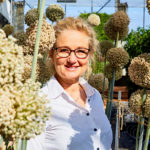Sweden
September 16, 2021

There is potential for commercial pea cultivation in parts of the northern Nordic region and green harvest of peas is possible above the Arctic Circle. That is one of the conclusions from NordGen’s research project Arctic Pea.
The impact of climate change is becoming increasingly clear, the debate is contributing to more consumers demanding plant-based foods. Peas are the most important protein crop in the Nordic countries with a long cultivation tradition in our region. Today’s commercial pea cultivation is, however, limited to southern latitudes in the Nordic countries. Increased domestic pea production would have been positive for Nordic food security and a climate-smart alternative to imported soybeans.

Lise Lykke Steffensen, executive director at NordGen.
– We are facing enormous challenges and it is becoming increasingly clear that we must act now. It requires that we preserve, but also begin to use, the genetic resources we have access to. Growing peas in northern Norway may sound impossible, but it is not, says NordGen’s director, Lise Lykke Steffensen.
Is there a potential to grow peas in more northern latitudes? This issue has been investigated in the Arctic Pea research project, which aims to identify genetic resources of peas that are suitable for plant breeding or can be grown directly in northern areas of the Nordic region. Results from the project have now been published in the scientific journal Frontiers in Plant Science.
Green harvest in Tromsø
The project used 50 accessions selected from NordGen’s pea collection, which includes over 2000 different types of peas. During the years 2018 and 2019, the selection of these was tested in four different locations in the Nordic region: Tromsø (Norway), Umeå (Sweden), Jokioinen (Finland) and Taastrup (Denmark). At the two southernmost cultivation sites, Taastrup and Jokioinen, full maturation was reached for all seed samples in both years. This means that it was possible to harvest dry peas. In the northernmost location, Tromsø, no plants reached full maturity. In 2018 though, 21 accessions reached green maturity and during 2019, 35 pea accessions reached the same stage.

Karolina Aloisi, responsible for NordGen’s molecular laboratory and one of the article’s co-authors
– It is important to get the peas in the soil as early as possible in the spring. They should have time to flower, form peas and, depending on the type, also have time to dry. We did not reach the last phase in Tromsø because of the early frost. But green peas worked well even in the northernmost experiment, which shows the potential for pea cultivation this far north, says Karolina Aloisi, responsible for NordGen’s molecular laboratory and one of the article’s co-authors.
Landraces did well
Among the accessions that had high seed yield (about 13 dry grams of seeds per plant) were one cultivar and three landraces, i.e. populations of cultivated plants adapted locally where they were grown but not developed by commercial plant breeding. Also when it came to the protein concentration of the peas, a number of landraces ended up at the top. Two landraces and two cultivars showed a protein concentration above 27 percent.

Ulrika Carlson-Nilsson, NordGen’s senior scientist responsible for grain legumes and co-author of the article.
– Many of the landraces included in the study have a northern origin, but there are also examples of southern landraces that work well at all experimental sites. Landraces often have a greater genetic variation compared to cultivars, which can contribute to them being successful from north to south, says Ulrika Carlson-Nilsson, NordGen’s senior scientist responsible for grain legumes and co-author of the article.
Northern niche crops
Landraces of sugar peas with a northern origin were among the seed samples that did best in the northernmost cultivation sites, Tromsø and Umeå.
– The study indicates that sugar peas have the potential to become a niche crop for farmers in the north. There are cultivation opportunities already in the existing material, but it would also have been interesting to do further studies for plant breeding purposes, says Ulrika Carlson-Nilsson.
 The landrace “Biskopen 2”, one of the sugar peas included in the study. The photo was taken in Tromsö 2018.
The landrace “Biskopen 2”, one of the sugar peas included in the study. The photo was taken in Tromsö 2018.
Facts: Arctic Pea
In the study, 50 accessions from NordGen’s pea collection were cultivated, of which 37 were landraces, 11 cultivars and two breeding lines. The peas were grown in four places: Tromsø, (Norway, latitude 69), Umeå (Sweden, latitude 63), Jokioinen, (Finland, latitude 60), Taastrup (Denmark, latitude 55).
Different types of peas were represented, such as sugar peas and shelling peas which are harvested and eaten green, but also peas that traditionally are harvested dry. Field peas (often referred to as grey peas or fodder peas) were included as well.
In addition to NordGen, the project included the following partners: Norwegian Institute of Bioeconomy Research (NIBIO), Natural Resources Institute Finland (Luke), University of Copenhagen, Boreal Plant Breeding, Danish Seed Savers and Stockholm University.